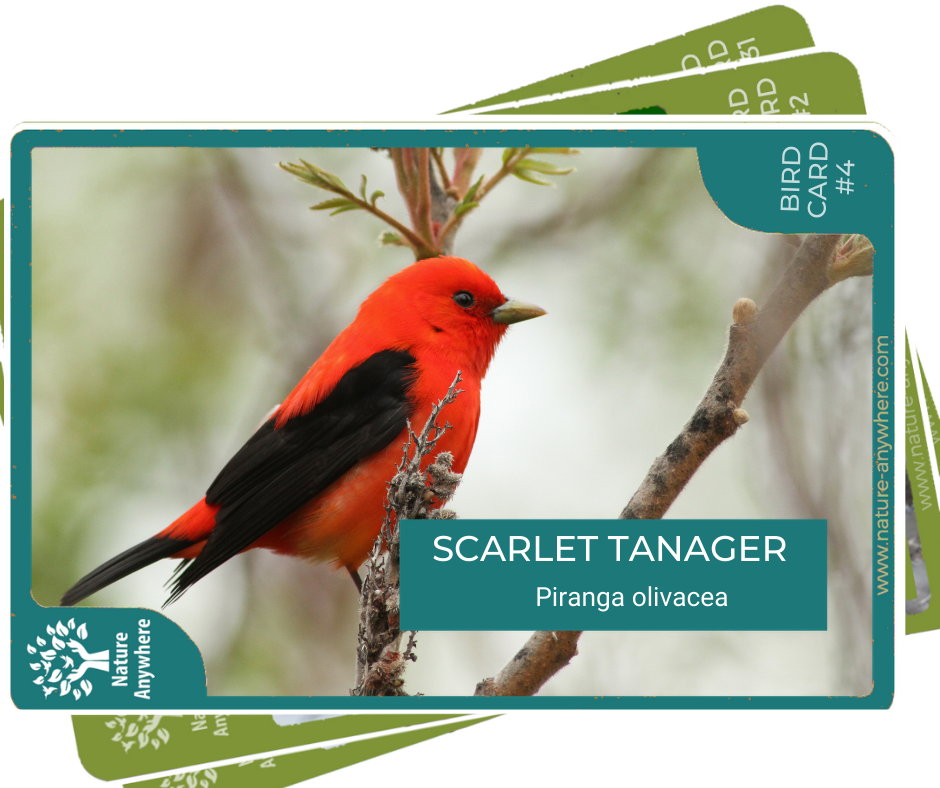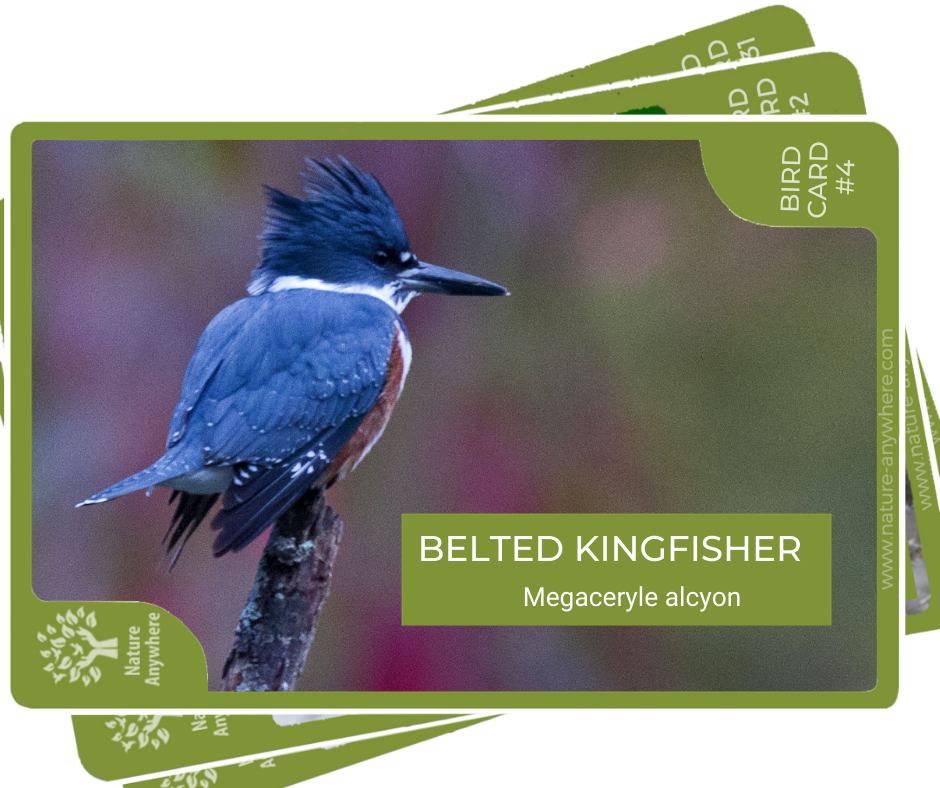
We all light up when we see northern cardinals visit our windows - it lifts the heart to see them!
But there is another visitor, not as frequent, who brings with him the same magic when he appears - the Scarlet Tanager. They look as though they should be flitting around the tropics or in a rainforest, which is where they spend their winters, but luckily for us, they like to breed in our neck of the woods!
The Scarlet Tanager is one of the 5 species found in North America: there are also summer, western, hepatic and flame-colored tanagers.
Scarlet Tanagers are mostly found in the eastern parts of North America. When you see them or hear them, it is a welcome sign that winter is coming to a close.
They sometimes migrate in the spring with other flocks as they are social birds. They sing their unique songs as they look for deciduous forests, preferably oak trees, in which to spend their summers.
Come winter, they migrate back south toward Panama, maybe even as far as Bolivia. Their migration route is one of the longest of any songbird. They usually fly at night.
Scarlet Tanagers roam around and perch high in the forest trees and are not at all easy to spot. When you hear their harmonious warm song, don’t move, just sit quietly and wait for them to appear. It’s worth it to see that flash of red in a sea of green.
LOOK

The genus name Piranga means an"unknown small bird." Olivacea from olivaceus, the latin word for olive-green.
Scarlet Tanagers are about 6-7 inches long and weigh over an ounce. The males look like superheroes with their bright scarlet-red bodies and black tails and wings.
The plumage of the females is completely different: yellow-green with yellow around their throats and sides with brownish-grey wings. Both sexes have small stubby bills, almost tooth-shaped, so they can crack open berries and seeds.

Between July and September, the adult male’s red feathers start to molt, which is why you may see quite a few males with red patches. They slowly change into a completely different color - a greenish yellow like the females, except they retain their black wings and tails.
Juveniles resemble adult females with brighter yellow and black wings and scapulars, the body feathers that cover the top of the wing. Female juveniles have greyer wings.
EATS
Scarlet Tanagers are diurnal (active during the day) though we hardly see them as they roam high up in the leafiest tree canopies. They are known for their “sallying technique,” which means catching insects in mid-flight. Once they have nabbed their flying lunch, they will return to the same perch every time.
Scarlet Tanagers are also ground feeders. In the summer they eat insects such as spiders, worms, hornets, ants, sawflies, moths, butterflies, beetles, flies, cicadas, leafhoppers, spittlebugs, treehoppers, termites, grasshoppers, locusts, dragonflies and millipedes.
In winter when insects are scarce, they turn to berries such as red mulberry, elder, sumac, raspberry, huckleberry, serviceberry, chokeberry and strawberry. Having berry shrubs like these in your garden gives you a better chance of luring them to you.
BIRDFEEDERS
This is a tall order - but not impossible. With scarlet tanagers, you blink - you miss. So either keep one eye on your birdfeeder at all times or install a vid-cam, just in case you missed them in that one half-hour you left the house!
Scarlet Tanagers prefer any berry offerings - even insect/berry suet as a substitute to their protein diet. So offer them either a suet feeder or a tray feeder with shelled sunflower seeds.
SOUND
Scarlet Tanagers have a deep, warm, slightly raspy chk-brrr, unlike other types of tanager. They almost sound like a robin with a sore throat.
Males sing during migration at night. So if you hear chk-brrr during the twilight hours, you may well be in the presence of a scarlet tanager.
SCARLET LOVE
Once spring arrives, the males “spring” into action. They become very aggressive as they defend their territories while preparing the nesting area. Then - in a surprising and interesting move - they become silent for courtship.

Scarlet tanagers are serial monogamists, creating one brood per season. The male stands on a branch below the female as he silently extends his neck and opens his wings to show off the brightness of his red neck and body.
Once coupled, the work begins. Well, it does for the female. Because the male is so easy to spot, he goes straight into hiding. The female chooses the location for their nest then starts building it.
This is usually a shallow bowl made of twigs, grass, stems, whatever she can find, usually at the end of a shaded, horizontal branch up to 75 feet (!) off the ground. It takes her about 3-4 days to finish the nest.
She lays 3-5 pale bluish-green eggs with small brown splotches and then incubates them for about 14 days. The young’uns leave the nest about 10 days after hatching.
FUN FACTS
Worm cleaners
Gardeners love scarlet tanagers for their highly efficient worm-cleaning. One scarlet tanager was recorded as having eaten 600 tent caterpillars in 15 minutes.
A group of tanagers walk into a bar
A group of tanagers is called a “season of tanagers”
Defense system
Scarlet Tanagers vary in their defense tactics. If an Eastern bird or oriole attacks them - they will swoop around and loudly chirp their mind. But if it is a bigger predator, such as an owl or a crow, they will freeze and not make a move.
It stings!
When Scarlet Tanagers capture bees, wasps and hornets, they shake their prey and bang it on a branch to remove their stingers before eating them.
True or false?
The famous “fun fact” of one gardener who recorded a Scarlet Tanager eating over 200 gypsy moth caterpillars in an hour is fake news.




1 comment
Charlotte Moore
I have your wonderful Birds I View window feeder, which I love. However a very rude squirrel has discovered it and constantly sits in it and often knocks the plate out onto the ground. Any advice on how to keep him off?
Leave a comment
All comments are moderated before being published.
This site is protected by hCaptcha and the hCaptcha Privacy Policy and Terms of Service apply.